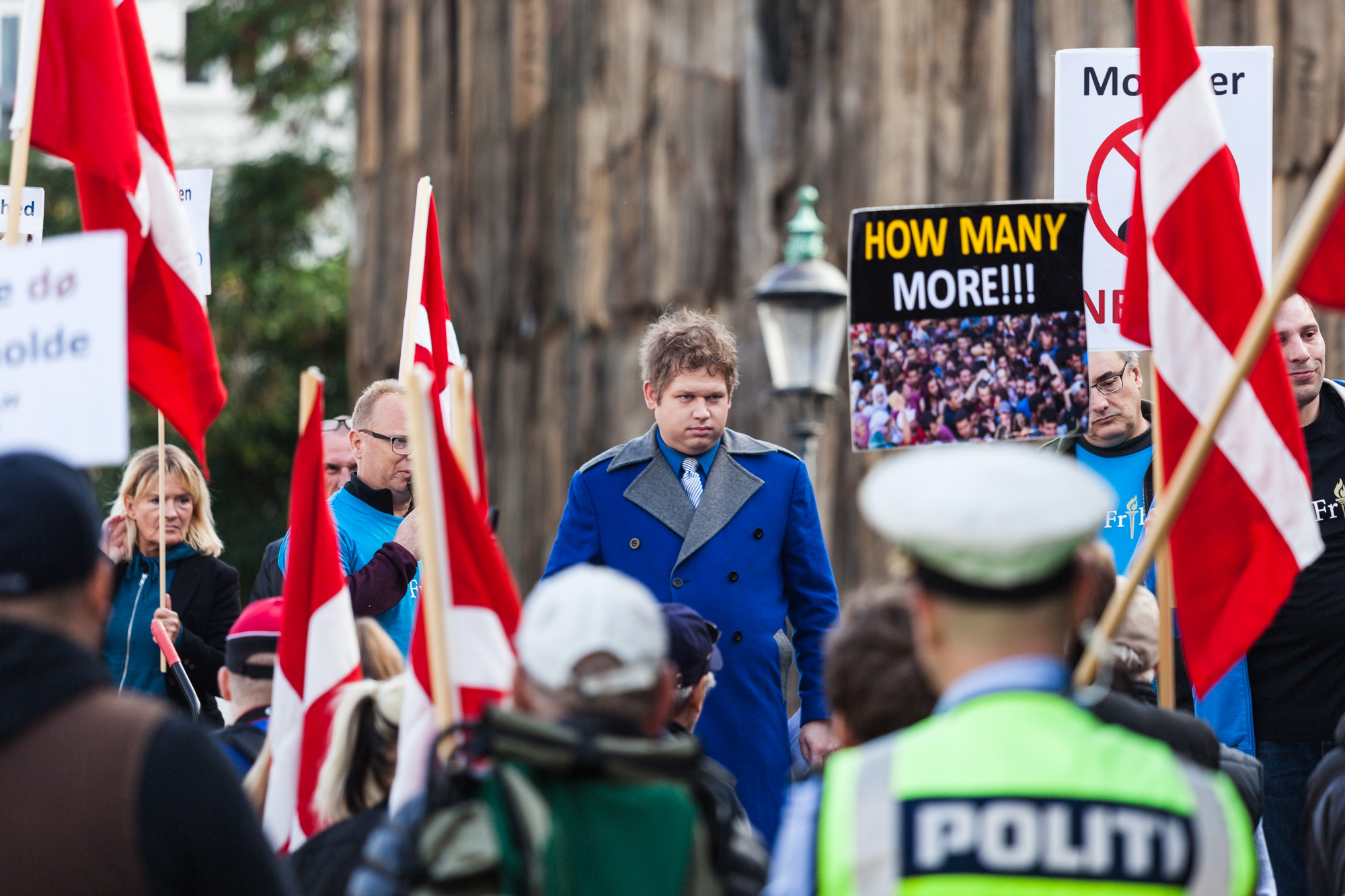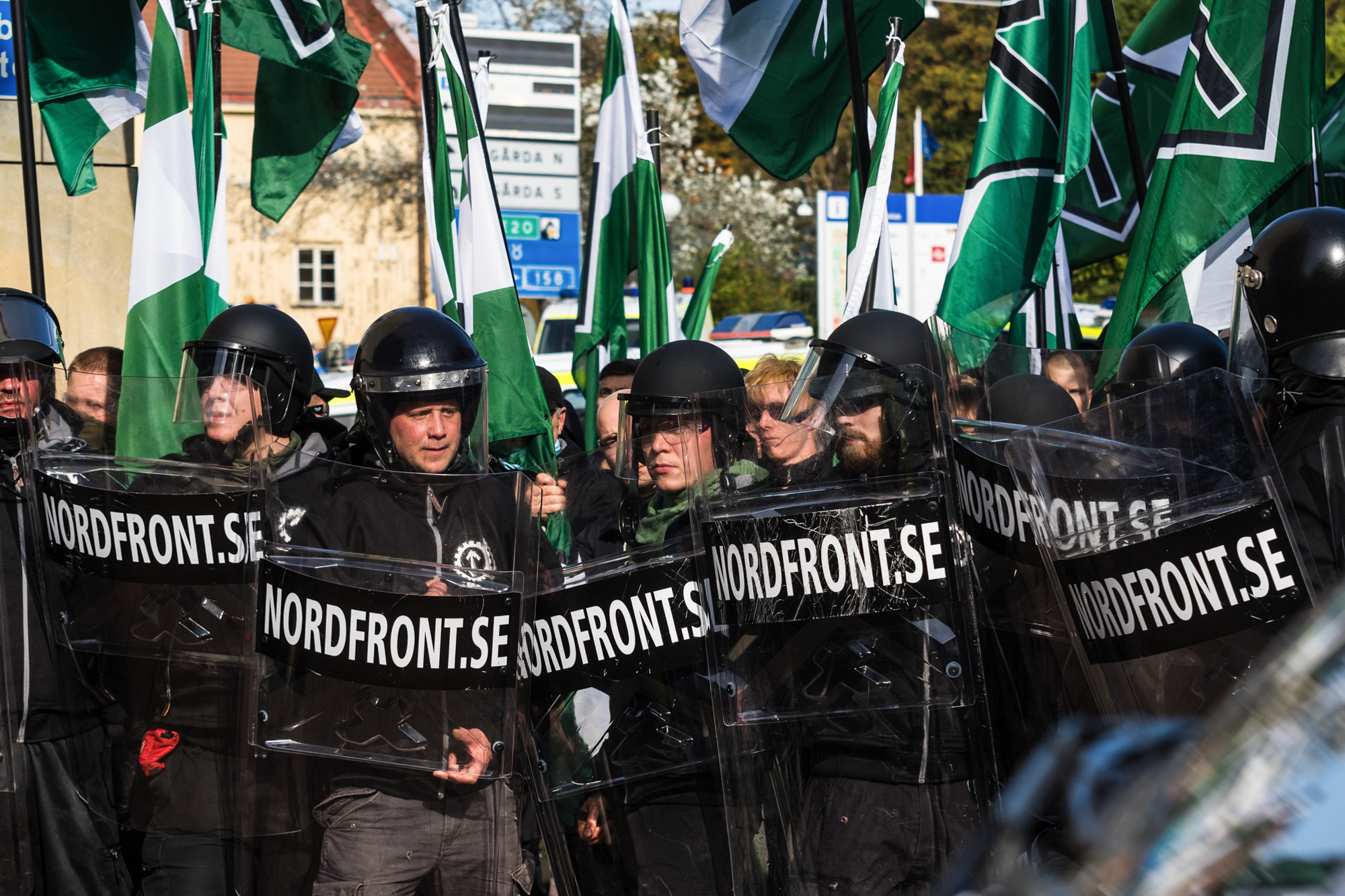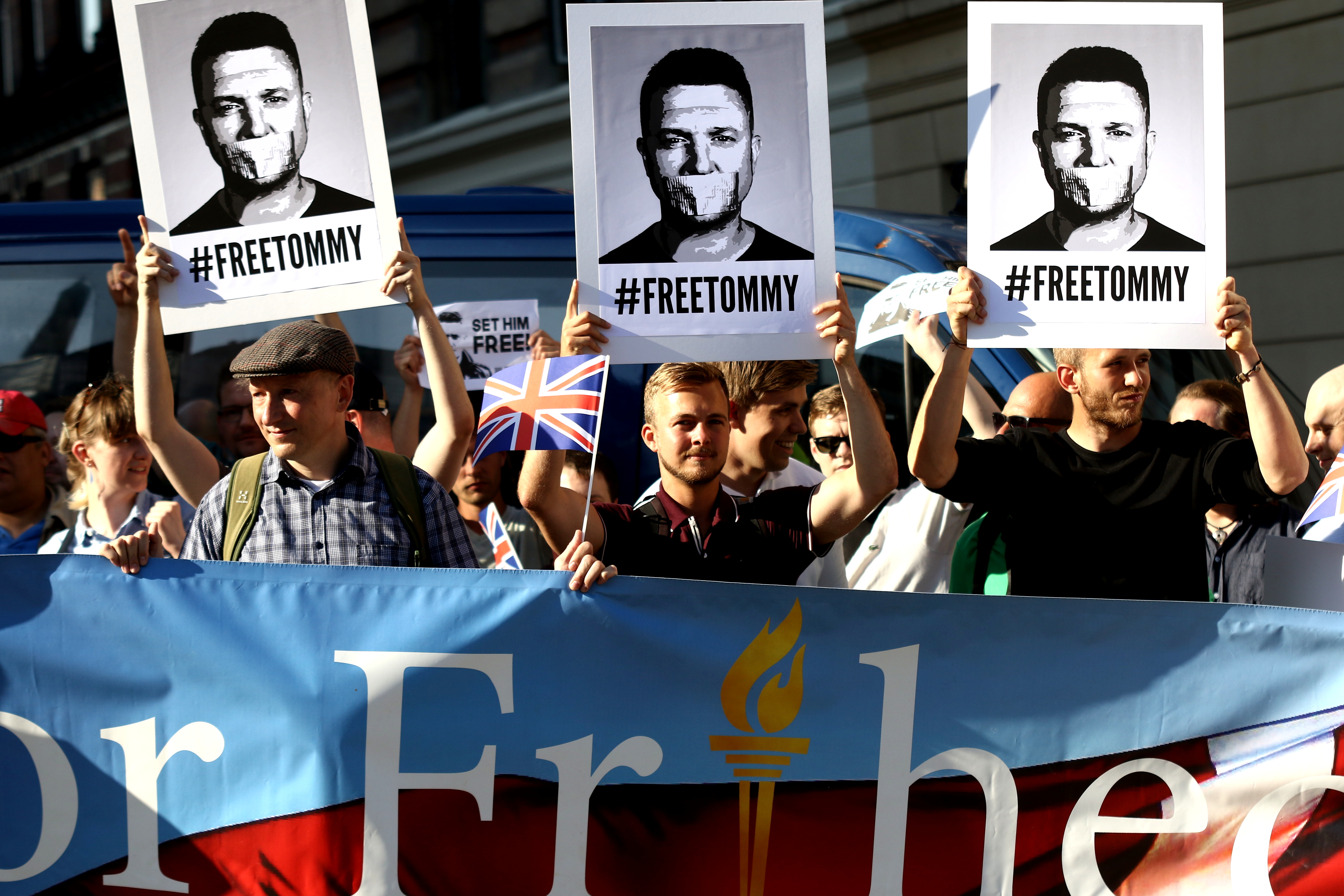New antimuslim party heading for Danish parliament while neofascists and anti-Semites take it to the streets
With parliamentary elections coming up its time to do an inventory of the Danish extreme right. We'll give you the lay of the land.
Publiceret den 13. marts 2019
Within the next couple of months, Denmark will elect new members of parliament. After more than 23 years of being the most right-wing party in parliament, Dansk Folkeparti (Danish People’s Party) is at risk of being overtaken by Nye Borgerlige (“Nye” meaning “new”, “Borgerlige” being a Danish catch-all word for centre-right ideologies, conservative or liberal). Nye Borgerlige was founded in 2015 and is headed by architect and former conservative politician Pernille Vermund. The party has even more anti-immigrant and anti-Muslim policies than Dansk Folkeparti, but at the same time represents the most liberal economical view in Danish politics.
The party is one of several new organisations in the Danish far right movement. With the elections just around the corner, it’s time for an overview of a movement which is looking to strengthen itself on the streets and in the parliament. We’ll do it in English for our international readers.
The architect and her biggest project
In autumn of 2015, a small group of former members of the Danish Conservative Party announced that they were forming a new party. The decision was based on growing frustrations with what they perceived as a soft stance on immigration, refugees and integration in the Conservative Party. Nye Borgerlige started gathering the 20.000 signatures required to run for parliament. They succeeded in less than a year, gaining media attention and several thousand new members.
In two aspects Nye Borgerlige is the most radical right-wing party in Danish politics: The line towards immigrants, refugees and Muslims is by far the most extreme. The other aspect is economic ideas, where the party represents the most ultraliberal standpoint seen in Danish politics for several decades, planning to lower taxes and drastically reduce the public sector.

Even though Dansk Folkeparti is one of the most successful far right populist parties of Europe, the growth of Nye Borgerlige is a sign of a general tendency in Danish politics. Not only the centre-right, but also the Social Democrats and to some extent the Socialist People’s Party, has adapted a populist view on matters regarding immigrants, Muslims and refugees in a historic rightward turn, leaving only far left and humanist parties as a small but vocal antiracist opposition in the parliament.
Nye Borgerlige is in many ways a heterogeneous organization. While many of the candidates and leading members have a background in other parliamentary centre-right parties, the party has attracted a lot of rank and file members from the extreme right. Even though the leadership comes from the centre-right Conservative Party, they also have political affiliations to the national conservative movement growing out of the large scene of right-wing blogs and alternative news sites. This was clearly demonstrated this winter, when journalists from Redox posing as undercover sympathizers of Nye Borgerlige tried to gain membership claiming to have a background in, the now defunct neo-nazi party, Danskernes Parti (Party of the Danes). 10 out of 10 local chairs in Nye Borgerlige gladly accepted the former members of the neo-nazi party.
Due to the many ties to even more far right organizations, the party has often been forced to expel members when they’ve been exposed as holocaust deniers or being too forward with their racist opinions. However, the leadership around Pernille Vermund is also very conscious not to expel every member who gets negative attention in the media or on social media, that would likely create too many internal conflicts. As of now the party seems to have found a middle ground where only the most controversial get expelled. However, the leadership might be forced to make even more expulsions as the election closes in and the media starts investigating members and candidates of the party.
Most polls place Nye Borgerlige above the two percent-limit, which is the minimum for getting a seat in parliament. Some polls are dangerously close to the limit, while others place the party around five percent.
Should the party succeed at gaining a seat in parliament, they might end up tipping the scale in favour of the right, giving current Prime Minister Lars Løkke Rasmussen four more years as head of government. However, this comes at a price. Nye Borgerlige has set up three non-negotiable demands for them to support a government run by Lars Løkke Rasmussen: A complete stop for giving asylum in Denmark, all foreigners in Denmark must be self-supporting and all foreigners will be expelled if convicted of a crime, no matter the severity. For now, it seems unrealistic that the Prime Minister would give in to all three demands.
The YouTube-warrior Rasmus Paludan
Another new phenomenon in Denmark is the lawyer turned party leader turned Youtube celebrity: Rasmus Paludan. With a background in the centre-right in his younger years, he was mostly known for his website where he exposed people driving their bikes on the pavement or jaywalking. He became a lawyer writing hostile poems about the police, curiously also one protesting the demolishment of the left radical Youth House in Nørrebro, which was torn down in 2007.
In 2015 he participated in a right-wing demonstration in Copenhagen organized by the local Pegida-inspired network. This was the start of a rapid radicalization process leading him to start his own media, “The Voice of Freedom”, and a political party called “Stram Kurs” (Hard Line). He started organizing small demonstrations with two to five participants in front of left-wing spaces, often resulting in him being ridiculed with humoristic banners and at one point being drenched with a bucket of what he claimed to be urine. After the long campaign against the Copenhagen left-wing scene with no outcome and abysmal election results at the municipal elections in 2017, Rasmus Paludan changed his focus.

Throughout 2018 he has been gathering signatures to run for parliament. At the time of writing, he has less than a quarter of the required 20.000 signatures. With elections being held at latest in June this year, he is pressed for time to get the missing signatures. This has driven him to become more provocative in his actions. From touring so-called ‘ghetto areas’, calling the residents “criminal losers” and protesting, in his words, ‘homo Islam’, things have escalated lately. After many threats to do so, he had a supporter burn a Quran after smearing it with bacon, while being protected by the police at a small demonstration this February. This is, for now, the latest from the lawyer who enjoys massive police protection every time he shows up to provoke the people he despises.
Even though Paludan is seen as brave by many on the far right, he has never succeeded building his party nor building a strong political group around him. Most of his followers online are teens and pre-teens, who favour his eccentric attitude but do not support him or his project. Despite many thousand weekly views on his YouTube videos he is politically isolated, even on the far right.
Bombmakers coming to Denmark
While the national conservative movement is joining the ranks of Nye Borgerlige, the extraparliamentary movements of the traditional national socialists and the neofascists are also gaining traction. In the last couple of years, the Danish fascist movement has been reshaped, since the crash in 2017 of the largest neo-Nazi party, Danskernes Parti. Two new organizations are dominating: the neofascist Generation Identitær, a part of the European identitarian movement of the same name, and the openly national socialist Nordic Resistance Movement.
We will start with the latter. The Nordic Resistance Movement, abbreviated NMR, was formed in Sweden. The last decade the group has seen successful expansions to Finland and Norway. An early attempt to organize in Denmark failed due to poor leadership.
Support us!
Did you know that you can support us financially even though you don’t reside in Denmark?
If you join our Supporters’ Collective, you will take part of financing our investigative journalism.
Every month you pay a fixed amount between 50 and 500 Danish kroner (between 8 and 77 USD or between 7 and 67 euro). We accept Visa, Mastercard, American Express and most of other major debit/credit cards.
Meanwhile, the parent organization in Sweden has also changed. From being a small sectarian part of the Swedish far right, the group is now the most dominant of the street active organizations. They are also the most violent, being involved in several attempted murders, knife attacks and a series of bomb plantings at refugee centers and a left-wing bookstore. Members of the organization have also been convicted of murder.
Now the militant group, by experts deemed as terrorists, has relaunched in Denmark. Over the last years the organization has stabilized with three local groups and very continuous activities. The activities range from putting up stickers and posters to banner actions on highway bridges and symbolic actions “closing off” disliked places using barrier tape. This was done to a café run by the LGBT-movement in Odense and a statue remembering the rebel Queen Mary who led the rebellion against the Danish colonizers on the isle of St. Croix in the Caribbean Sea in 1878. The group has also made campaigns against the so-called “gay lobby” and with openly antisemitic and holocaust-denying messages.
Since last summer the organization has started doing continuous street actions, normally on Saturdays, standing in the central streets of typically provincial towns, handing out leaflets for a few hours, afterwards publishing ‘action videos’ of the activities, with heroic music. NMR has also participated in demonstrations organized by the Swedish and Finnish divisions several times.
For now, the level of militancy in the Danish division is lower than in Norway, Finland and Sweden, but it is also still the youngest and smallest division.

On a positive note, the rise of NMR has enhanced the decline of two other national socialist organizations, The National Front of Denmark (DNF) and The National Socialist Movement of Denmark (DNSB). Whereas the DNF is a skinhead movement arising out the neo-Nazi Danish Front in the middle of the last decade, the DNSB is the traditional NS-party with historical ties to the Danish Nazi party during World War II. Neither of the two organizations have had an active leadership for several years and exist only through their name and a few, secret social gatherings each year. The amount of outward activities is close to zero. The DNSB still has a small headquarter in Greve, 25 kilometers southwest of Copenhagen, but the large parties and concerts are history for now.
Neofascist hipsters with French inspiration
The other far right group on the rise in Denmark is Generation Identitær. The group was formed in 2017 and has gained large support from the national conservative movement due to simple symbolic actions presented as cool, visually effective videos and pictures on social media. The actions are inspired by the other European divisions of the original French organization Generation Identitaire: A group of 8-10 activists, dressed casually, placed near a busy street or square with a large banner, perhaps supplemented by flares and/or shouting of slogans for a few minutes. After a quick exit, the real traction is gained on social media, when videos of the actions are shared. For the Danish division, even a simple banner action will get several hundreds of likes and shares and get momentum online.
The Danish Generation Identitær has an official age limit of 30 years. Most of the members are in their mid-twenties, typically studying or having just completed higher educations. GI has two local groups, one in Copenhagen and one in Aarhus, and most of their activities are confined to these two cities. However, GI is often participating in activities in other European countries organized by local divisions of the organization.

As of now both NMR and Generation Identitær are still small in terms of members. But both organizations have successfully launched local chapters and are, in their own ways, establishing themselves as the two go-to places for new supporters wanting to join a far right organization. If Nye Borgerlige fails in the elections, or if the Social Democrats regain power, the frustrations on the far right can easily lead to a rapid growth in the street-oriented neofascist and national socialist organizations. Regardless of the election results 2019 will reshape the far right in Denmark.
If you want to see more investigative reporting on the danish far right you can join our Supporter’s Collective to fund our research.